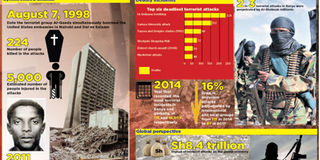Blunders that exposed US embassy to 1998 terror attack

What you need to know:
The Americans appeared to have lost the suspects’ scent.
Amazingly, the CIA didn’t follow up on the matter and the Nairobi al-Qaeda cell went on with “business” as usual.
The FBI raided the house of a key mastermind in the Nairobi bomb blast, Wadih al-Hage, and seized paperwork and digital data with crucial information on the planned terrorist attacks.
Early in 1997, the Director-General of the newly created National Security Intelligence Service (NSIS) Brig (rtd) Wilson Boinnet (uncle to the current Inspector-General of Police Joseph Boinnet) had written a comprehensive report on measures that urgently needed be taken for Kenya to be up to speed in combating the emerging threat of global terrorism.
Among his recommendations were establishment of a multi-agency counter-terrorism centre as a central liaison body in combating terrorism.
It would include officers from the NSIS, the police, the military, and the immigration, among others.
It would also closely liaise with friendly foreign counter-terrorism agents. He also recommended formation of an elitist, semi-autonomous anti-terror police unit within the Kenya Police.
WINNING POLLS
At the time Mr Boinnet made his recommendations, Kenyan authorities had their priorities fixated elsewhere.
1997 happened to be an election year and the powers that be had all their focus on winning the polls at the expense of everything else.
It would take nearly a decade before the two units recommended by Mr Boinnet, the multi-sectoral National Counter-Terrorism Centre and the Anti-Terrorism Police Unit, become fully operational.
Experts in counter-terrorism agree that masterminds of the 1998 bombing most likely would have been stopped in their tracks had structured and coordinated units been in place to combat terrorism.
CIA/FBI CAUGHT NAPPING
But it is not just the Kenya government that slept on the job in the lead-up to the 1998 Nairobi terrorist bombing. In his memoirs titled: At the Centre of a Storm, then CIA Director-General George Tenet says the US Nairobi embassy building had been “cased” (the anti-terrorism word for market out) five years early, in 1993.
Evidence would later emerge that lead terrorists in the plot had set up an operation base in Nairobi as early as January 1994.
It can now be disclosed that at the time Mr Boinnet made his report to the Kenyan authorities, the CIA had just raided offices of some NGO in Nairobi South C, the al-Haramayn Foundation, on a credible tip-off that the disguised outfit was actually involved in planning the terrorist bombings in Nairobi and Dar es Salaam a year later.
Amazingly, the CIA didn’t follow up on the matter and the Nairobi al-Qaeda cell went on with “business” as usual.
BOMB BLAST
At about the same time, the FBI raided the house of a key mastermind in the Nairobi bomb blast, Wadih al-Hage, and seized huge volumes of paperwork and digital data with crucial information on the planned terrorist attacks. Astonishingly, the captured materials remained untouched at the FBI offices. Reason: The agent couldn’t get someone to translate them from Arabic to English.
The former CIA head, Tenet, too, reckons that by 1996, US intelligence had established the whereabouts of al-Qaeda leader, Osama bin Laden, in Sudanese capital Khartoum, and from where planning of the embassy bombings in East Africa were coordinated.
The CIA had sought permission to kill Osama but was explicitly warned against it through a terse letter by then US Attorney-General Ms Janet Reno.
TERRORISTS' PARADISE
With Kenyan and US intelligence apparently clueless on the full penetration and activities of the Nairobi al-Qaeda cell, operatives in the latter were able to freely roam between Nairobi, Khartoum, and Mogadishu unhindered as they put final touches to the August 1998 attack.
While in Kenya, the lead mastermind of the bomb attack, Fazul Mohamed, moved undetected even as he used three different identification documents bearing different names and dates of birth.
These are Fazul Mohamed born August 25, 1972, Abdullah Fazul born on February 25, 1974, and Haroun Fazul born on December 25, 1974.
Within a year of setting base in Kenya in January 1994, the Comoro born Fazul had become so “local” that he could organise a lavish wedding in Mombasa for one of his accomplices in the Nairobi bombing, Mohammed Siddiq Odeh. On the very day of the bombing, August 7, Fazul had in the morning arranged for his father-in-law who had been hospitalised in Nairobi to be flown back home to the Comoros. Fazul himself would hang around in Kenya undetected for another whole week after the blast before he quietly slipped out to a hideout in Somalia.
PLEAS IGNORED
Even as plans of attack on the Nairobi US embassy building got to an advanced stage, then American Ambassador to Kenya, Ms Prudence Bushnell, had constantly called for installing of stronger protection measures, if not altogether relocating the embassy chancery, then at the junction of Moi-Haile Selassie avenues, but all her entreaties had fallen on deaf ears.
In her yet-to-be-published memoirs, she reckons that at the time of bombing, all preoccupation in Washington was on the possible impeachment of President Bill Clinton over the Monica Lewinsky affair.
An often overlooked aspect of the 1998 Nairobi terrorist bombing is that most of the deaths didn’t happen at the US embassy building, the target of the attacks, but at the adjacent seven-storey Ufundi House, which was completely flattened in the blast, making it the epicentre of death, and not the structurally stronger US embassy building or the Co-operative Bank Building (popularly called the Bell-bottom).
It can now be revealed that Ufundi House had been constructed under a pre-colonial 1954 Nairobi City Council approval that allowed the building to go only up to four floors.
However, through manipulation and corruption at the City Hall planning department in the 1980s, Ufundi House was illegally extended to seven floors despite the inherently weak structure to carry that weight, hence the speed and ease with which it came down on the fateful day.





